Sunday, March 09, 2008
Beijing, China, 29 Feb-2 Mar 2008: 老百姓
Common Folk
Less than 6 months to the Summer Olympic Games, Beijing is a hive of construction activities. In the Forbidden Palace, scaffoldings clad the 3 Great Halls, and modern slate tiles replaces uneven stone slabs gouged out from the ancient hallowed squares. Large parts of the traditonal Dazhalan quarters near Qianmen and hutongs adjacent to Wangfujing Street have been systematically torn down, their detritus shielded by giant billboards promising urban revitalization of meretricious appeal. The hoi polloi, 老百姓 Lao Bai Xing, soldier on bravely, immutable in the sea of change swirling around them. Guards at the Forbidden Palace shout at tourists who linger too long on the bridges leading to the south entrance. Hungry customers jostle to buy their lunch orders of steamed buns Xiao Long Bao. Intrepid office workers brave the jungle of commuters on the subway and public buses. Brusque security guards patrol the busy warrens of shops selling luxury knockoffs in the Silk Street Bazaar. Life goes on. Amid the rush, there is time for reflection. Monks and nuns take in the sights at the Forbidden Palace, sharing in lunchtime victuals on the benches outside Qianqinggong, the Inner Palace. In Beihai Park, enthusiasts huddle together and sing heartily to violin accompaniment on a crisp late winter Friday afternoon. A solitary man carefully wields a large water brush over the pavement, his ephemeral writing drying up and disappearing with the angled rays of the setting sun. |
Labels: Beijing, China, garden, lake, palace, people
Friday, March 30, 2007
Bangkok, Thailand, 13-16 Jan 2007: Grand Palace
All That Glitters IS Gold
  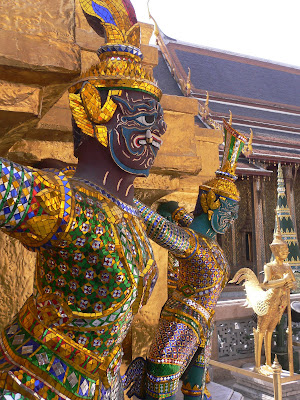 |
| Reigning supreme on the east bank of Bangkok's Chao Phraya River, the Grand Palace is the historical and cultural heart of the city. Scrupulously preserved, the surfaces of the temples are either densely covered with intricate colourful mirrored tiles or lovingly applied with layers of gold leaf. Phantasmagorical demons in classical poses buttress glittering tall chedi, forbidding entry to the gilded steps that lead to heaven. Palace rooftops stir alive as slender gold curved spires leap skywards from the apices. |
  |
Labels: art, Bangkok, palace, religious site, Thailand
Sunday, March 25, 2007
Seville, Spain, 23 Feb 2007: Real Alcazar y Catedral
Mudejar Palace And Gothic Church
  |
| The Christian monarchs Alfonso X and Pedro I (the Cruel) employed Moorish artisans to build the Real Alcazar in the 14th century. The latter allegedly abandoned his wife, preferring to cavort with his favourite mistress in his new pleasure palace. The Alcazar houses fantasy courtyards like the Patio de las Doncellas and delightful gardens that combine a curious blend of Moorish and European influences. It remains the most complete and well-preserved specimen of Mudejar architecture in Spain. |
  |
| Seville Cathedral is the world's third largest cathedral (after Vatican's St Peter's and London's St Paul's) and largest Gothic cathedral. Built on the site on a former mosque, only the minaret - refashioned as a bell tower La Giralda - and the orangery at the entrance remain. Climb up a seemingly endless series of ramps (designed to allow passage of sentries on horseback) to get to the top of the Giralda. From there, enjoy panaromic views of the massive naves of the Cathedral, the nearby Real Alcazar and the traditional dwellings of barrio Santa Cruz. |
     |
Labels: architecture, museum, palace, religious site, Seville, Spain
Granada, Spain, 21-22 Feb 2007: Alhambra Grounds
Generalife, Palacio de Carlos V And Alcazaba
   |
| The Generalife at the northeastern tip of the Alhambra was the private pleasure garden of the Sultan. The peaceful quiet of the Water Garden is broken only by tinkling sounds emanating from the fountains. From the Generalife, cross the cypress-lined bridge walkway straddling the Rio Darro to get to the rest of the Alhambra grounds. |
   |
| After conquering the Moors, the Spanish Christian Monarchs continued to reside in the Alhambra. King Charles V commissioned the building of a Renaissance Palace next to the Nasrid Palaces. The exterior is a monumental square edifice, while the interior comprises a round open court surrounded by double rows of classical Ionic atop Doric columns. |
   |
| The Puerto del Vino divides the municipal and military compartments in the Alhambra. From under the gate's arched entrance, the Alcazaba stretches out to the southwestern limits of the palace, framed by the distant Sierra Nevada. Mighty towers loom over the city of Granada at the fortress' feet, vigilantly guarding the isolated Sultan against his populace. |
Labels: architecture, art, Granada, palace, religious site, Spain
Granada, Spain, 21-22 Feb 2007: Alhambra, Palacios Nazaries
The Mexuar, Comares And Leones Palaces
   |
| The Moorish Nasrid Palaces are the Alhambra's jewels. The complex consists of three interconnecting palace groups - the Mexuar Palace, the Comares Palace and the Leones Palace - and the Lindaraja Gardens. Elegant uncluttered lines and spacious courtyards harmonize with ingenious use of water landscape to create an oasis of unrivalled beauty. Due to Islam's prohibition against the use of imagery, the walls and ceilings of the palaces are replete with intricate geometrical designs and religious calligraphic art. They permeate the buildings - integral to the whole, never overwrought - subtly transforming with every shifting light throughout the day. The artisans used plaster almost exclusively for decorative stucco work and were experts in delicate alicatado mosaic tiling. They seemed to be cognizant of the impermanence of the worldly Earth, reveling in the ethereal frailty of their creations. |
 |
| The Courtyard of the Mexuar leads from the Hall of the Mexuar to the Comares Palace. At the adjoining Golden Chamber, visitors waited to be admitted to the Nasrid Sultan's presence. On the southern side of the courtyard is an impressive facade of foliate stucco work that becomes increasingly intricate as the eye scales the wall. |
  |
| The Comares Palace is the nucleus of the Nasrid Palaces. Simplicity of line and balanced proportions lend a serene majesty to the Courtyard of the Myrtles. The Comares Tower appears to magically float on the reflecting pool. Pluck a few leaves from the myrtle shrubs and rub them between the fingers - they emit a most wonderful and refreshing scent. |
  |
| Leave the Courtyard of the Myrtles, and enter the Hall of the Boat. Observe the play of reflected light on the jambs at the entrance. Enter the Hall of the Ambassadors or Throne Room - the palaces' most sumptuously decorated room. Imagine the effect the Sultan had on his minions as he loomed half hidden in the shadowy central alcove at the far wall, silhouetted against the dappled light that filtered in through the filigree stained glass wall. |
  |
| The Leones Palace was the Sultan's private dwellings. The central Courtyard of the Lions is surrounded by myriad slender columns - perhaps reminiscent of the palm trees in a desert oasis in the Sultan's longed-after homeland. The fountain with twelve lion statues, spouting water from their mouths, has been temporarily dismantled for conservation work. |
   |
| The Hall of the Abencerrages and the Hall of the Two Sisters face each other on opposite ends of the courtyard. Both boast magnificent honeycombed plaster mocarabes ceilings. Legend has it that the former was believed to be the site of the infamous slaugther of the Abencerrages clan for one male member's alleged affair with the Sultana. The Hall of the Two Sisters, named for two large flawless slabs of Macael marble at the centre of the floor, leads into the Mirador of Lindaraja. The mirador's beautiful mullion window in the north wall overlooks the Lindaraja Garden, with trickling fountains set amidst fragrant orange trees. |
   |
Labels: architecture, art, Granada, palace, sculpture, Spain
Granada, Spain, 21-22 Feb 2007: Heart of Andalusia
View Of The Alhambra From The Albaicin

| Thirteen years ago, I read James Michener's Iberia. His heartfelt and personal reflections on Spain, a country he loves, has fired my fascination. Andalusia in the south of Spain, and above all the Alhambra, beckon alluringly. I finally get to see the palace now: the Alhambra glows a warm golden hue in the sunset. |
 Crowds - romantics, tourists, pensioners, hippies - congregate every evening at the Mirador de San Nicolas Church, high up in the Albaicin hill district. Some enjoy the view of the Alhambra quietly, others sing raucously. All celebrate.
Crowds - romantics, tourists, pensioners, hippies - congregate every evening at the Mirador de San Nicolas Church, high up in the Albaicin hill district. Some enjoy the view of the Alhambra quietly, others sing raucously. All celebrate.Labels: architecture, Granada, palace, Spain, sunset
Sunday, July 09, 2006
Beijing, China, 16-19 February 2006: Imperial Palaces
Forbidden Palace & Summer Palace, In Winter
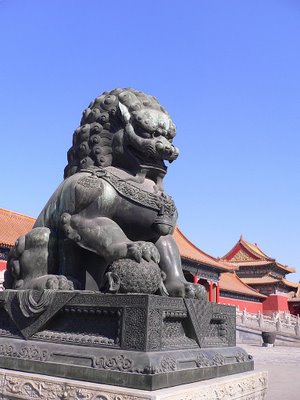 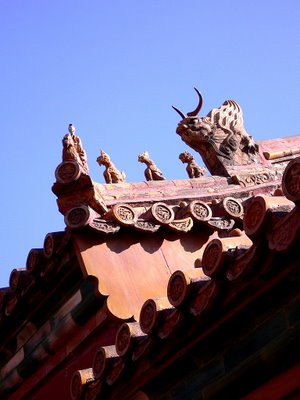 The Forbidden Palace was the seat of Qing dynastic rule for over 400 years. Guardian lions and fantastical rooftop beasts stand in perpetual vigil, casting magic protection over the Manchu emperor and his royal retinue. Emperor Qian Long reigned 60 years. His calligraphic inscription Zheng Da Guang Ming - Incorruptible Righteousness - hangs above his throne. 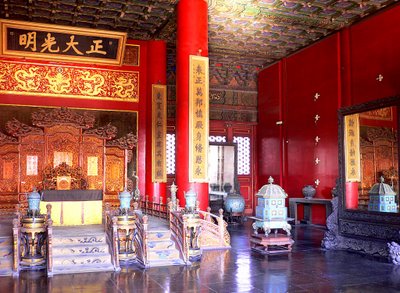 |
  Believed to ward off evil charms and spirits, auspicious red is everywhere. Palace walls and courtyard gates are coated in burnished crimson hues. Delicate ceramic tiles with recurring floral peony motifs adorn walls and columns. 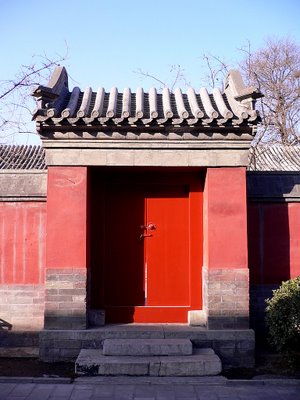 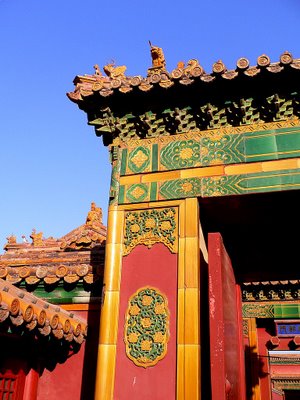 |
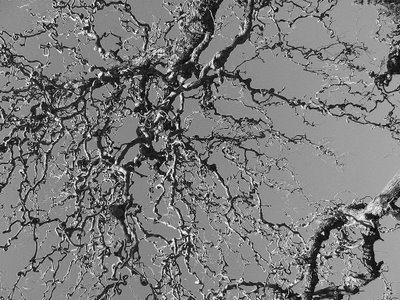 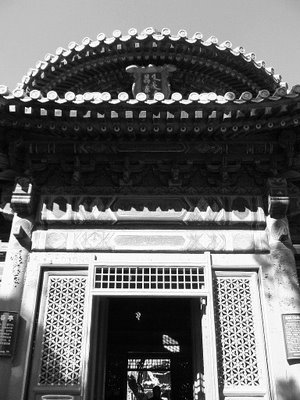 The Imperial Garden, behind the royal palaces, edges the northern palace wall. Within its compact compound, stylized rock sculptures, miniature pavilions and countless ornamental trees, centuries old, are meticulously laid out, no doubt after strict Feng Shui principles. |
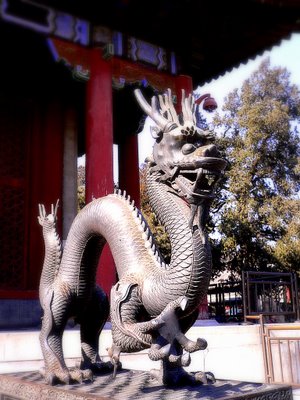 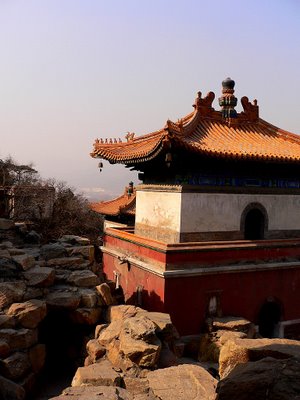 The Summer Palace, Yi He Yuan, was rebuilt following Western army ruination, using war funds expropriated by the infamous Empress Dowager Ci Xi. It became her summer Xanadu. Palaces were erected on Wan Shou Shan - Longevity Mount - and on the banks of Kunming Lake at its base. Temples built for imperial religious edification dot the landscape. Times have not been kind. Beheaded Buddha statues are scarred reminders of zealous cultural purification in the 60's. 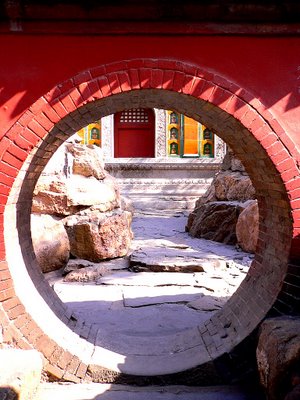  |
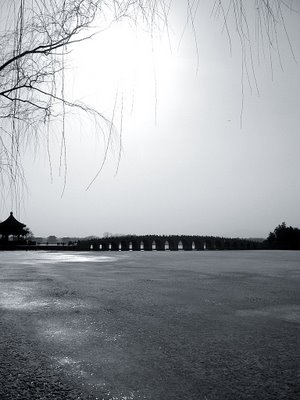 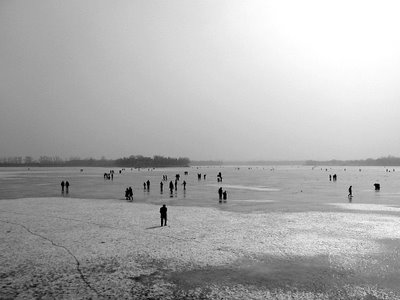  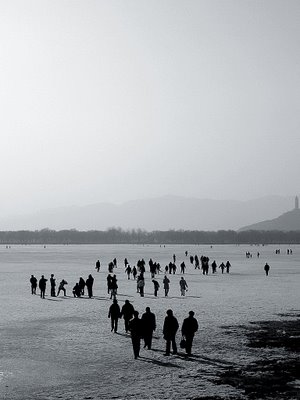 |
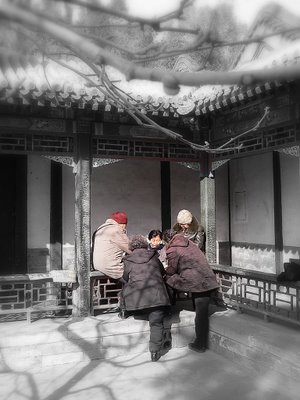 A long gallery Chang Lang connects the pavilions ringing Kunming Lake. Strolling, I chance upon these women playing cards. With impenetrable quiet concentration. |
Labels: Beijing, China, history, lake, palace, religious site

Licensed under Creative Commons Attribution-NonCommercial-NoDerivs 2.5 License

These are the 30 countries that I have ever set foot on. Airport stopovers don't count!
